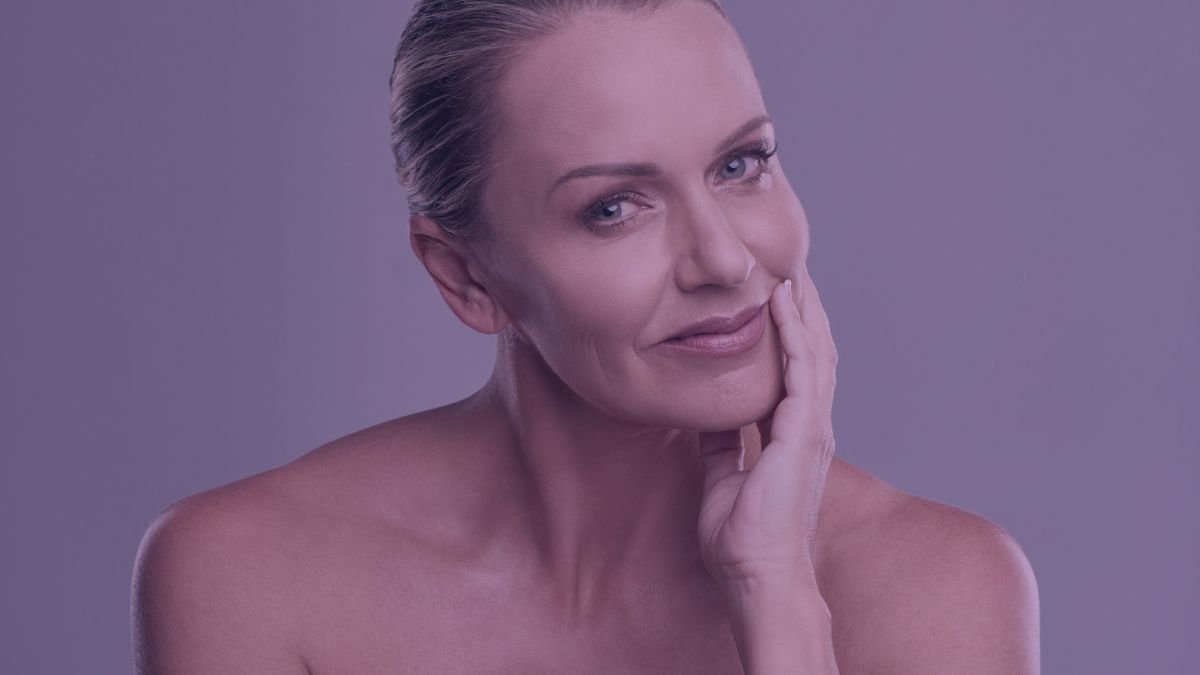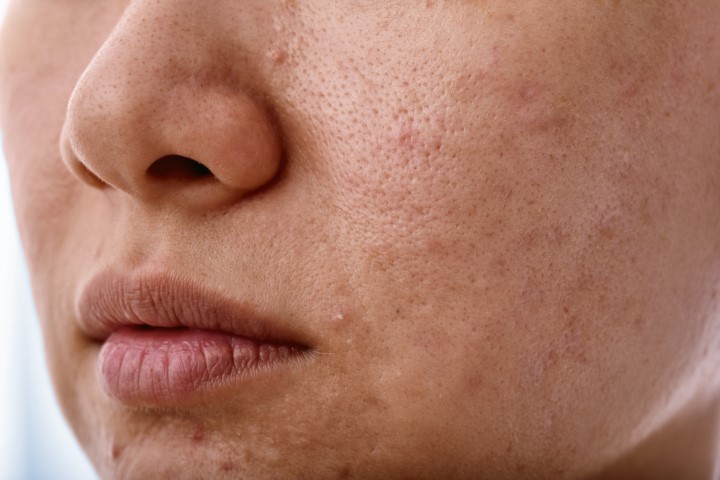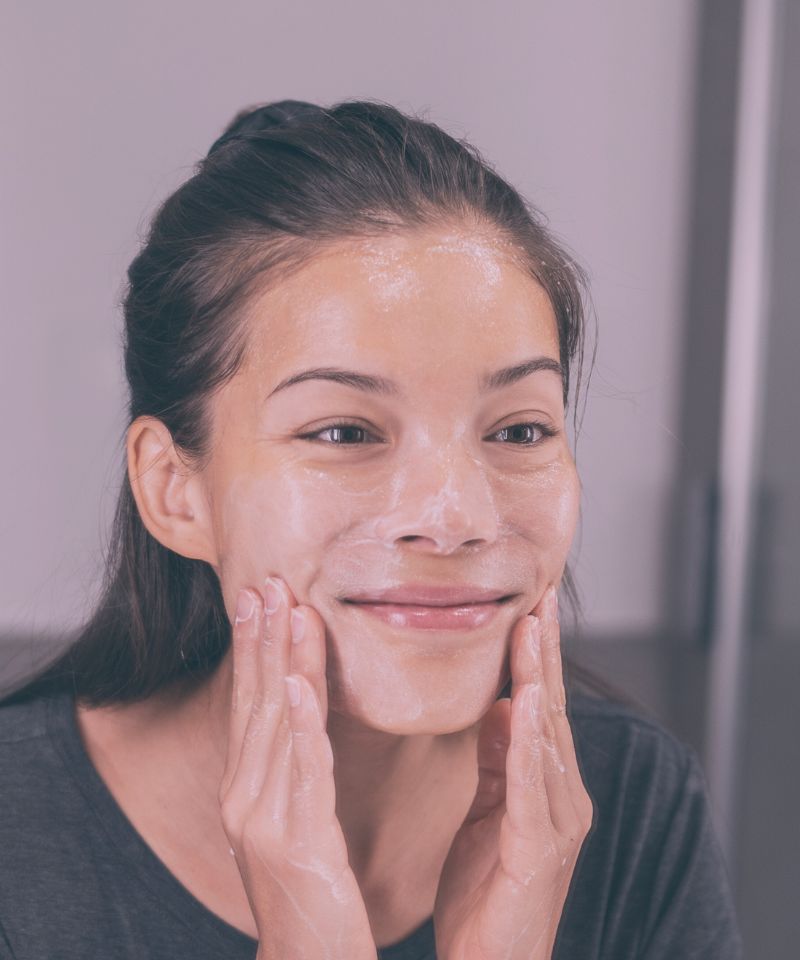Congested skin is a harmless cosmetic condition that manifests on the skin in the form of excess shine, bumps, blackheads, pimples, and discoloration and is particularly common in young adults while going through hormonal changes.
However, while prevalent in a younger demographic, anyone can experience congested skin, including adults who have left the problematic puberty changes far behind.
Therefore, in this article, we will explain what exactly is congested skin, which factors influence its appearance, and, most importantly, how to clear it quickly and safely.

What is Congested Skin?
Congested skin is a condition where your pores are blocked by a mixture of oil, dead skin cells, and residues from everyday debris, such as makeup and skincare products that haven’t been thoroughly removed and have burrowed deep into your skin.
It is like your skin is stuck in a continuous traffic jam, impeding the natural exfoliation process and leading to a compounding of impurities.
Congested skin also sets the stage for many skin concerns, including inflammation and acne, along with dull, uneven texture and a sallowy complexion.
What Does Congested Skin Look Like?

Congested skin often appears as whiteheads, blackheads, and bumps on the skin’s surface and may also look rough and textured or feel bumpy to the touch.
How Different Skin Types Experience Congestion
Different skin types experience congestion in different ways.
Therefore, whereas some people experience it in the form of bumps and breakouts, others may experience it as a grey complexion that lacks luster.
Here’s how different skin types experience congestion:
Dry Skin
Dry skin struggles with producing oil, leading to dead skin cells accumulating on the surface and blocking the pores.
Dry skin types can experience congestion as rough, dry patches, and they’re more prone to flakiness and a dull appearance.
Oily Skin
On the other hand, oily skin produces excess oil, which can mix with the skin cells and external grime, causing congestion inside the pores.
This often appears on the skin as enlarged pores, breakouts, bumps, and a shiny complexion.
Combination Skin
Combination skin, being a mix of oily and dry, can experience congestion in the T-zone (forehead, nose, and chin), where oil production is higher.
The drier areas might get clogged pores due to accumulated skin cells, while oily areas might appear shiny and experience bumps and breakouts.
What Causes Congested Skin?
Congested skin can be caused by multiple factors, including hormones, excess oil, unshed skin cells, clogging cosmetics, and environmental factors.
Here are a few common causes of congested skin and how exactly can exposure to each of these triggers worsen the pesky condition:
Excess Oil
Excess oil is one of the main causes of congested skin.
Clogged pores are caused mainly by the accumulation of oil that hasn’t traveled through the passage and to the skin’s surface, where it serves as a natural moisturizer and mild protection against environmental aggressors but has instead remained stuck inside and hardened, causing a stiff plug.
This blockage can also be aggravated by dead skin cells that become glued to it and remain trapped inside the pores, causing congestion.
Hormones
Hormonal imbalances can cause congested skin as when certain hormones are elevated, they will directly stimulate the sebaceous glands to produce excess oil, which then gets stuck inside the pores.
Hormonal imbalances, such as elevated androgens, cortisol, and insulin, can also cause inflammation, leading to skin conditions such as acne.
Dead Skin Cells
Our body naturally sheds around 500 million dead skin cells a day.
However, as our skin cells travel toward the skin surface to be shed, they can get glued to the sticky oil plug inside the pores and contribute to congestion.
The unshed dead skin cells will then attract a strain of bacteria that feed on the cellular debris, enabling it to overgrow and lead to inflammatory conditions such as acne.
Clogging Ingredients in Cosmetics
Clogging ingredients in skincare, makeup, and hair care products can get stuck on our skin and burrow deeper into the pores, further contributing to congestion and breakouts.
This is why cleansing your skin with a gentle, gel-based cleanser daily is critical to avoiding congestion.
Poor Facial Hygiene
Poor facial hygiene, such as not washing your face regularly, allows the accumulation of cellular debris, dirt, pollution, and residue from cosmetics to build up on the skin and get deeply embedded in the pores, leading to congestion.
Skin Elasticity
As you age, your skin’s natural elasticity declines. This can contribute to enlarged facial pores, according to one small study.
Once pores are enlarged, they can be magnets for dirt and oil, forming blackheads and whiteheads over time.
Pollution and Environmental Factors
Pollution, dust, and other environmental factors can clog your pores with particles that can’t be washed away with just water.
This can lead to textural and inflammatory issues, causing your skin to become congested.
Symptoms of Congested Skin
What does congested skin look like?
Well, congested skin is often characterized by a distinctive set of visual cues that you can easily recognize.
Here are the most common signs and symptoms of congested skin:
Clogged Pores
Clogged pores are one of the most common problems that result from congested skin.
The accumulation of excess oils, dirt, and dead skin cells can cause your pores to become blocked and unable to serve as a passage for oil and dead skin cells to reach the surface.
Enlarged Pores
As the pore accumulates more oil and skin cells, its lining will expand to accommodate the cellular debris.
This will make the pores look enlarged and contribute to uneven skin texture.
Acne Breakouts
When the debris-eating bacteria inside the pore overgrows enough to trigger the immune system, it will result in a breakout.
The immune system will fight this bacterial overgrowth by sending white blood cells to the area of infection, which will result in inflammation, swelling, and redness we see on the skin as pimples.
Blackheads
Blackheads are a non-inflammatory type of acne and a common occurrence as a result of prolonged congestion.
Blackheads occur when the plug of hardened oil and skin cells inside the pores oxidizes at the tip due to exposure to oxygen on the outside and turns black.
Whiteheads
Whiteheads, or closed comedones, occur when the plug is completely sealed off from contact with air, which will prevent oxidation and keep the cellular debris white or yellowish.
However, since a thin layer of skin covers the plug, whiteheads will typically look like flesh-colored bumps or tiny, non-inflamed pimples on the skin.
Pustules
Pustules are an inflammatory type of acne and occur when a whitehead becomes infected by bacteria, triggering the immune system to fight back with inflammation.
The infection will cause the cellular debris to become puss-filled, resulting in small red bumps with a white tip on the skin.
Papules
Papules, or blind pimples, occur when a whitehead gets infected, and the immune system triggers inflammation without any puss forming inside.
These will look like small red bumps on the skin and can be hard and painful to the touch.
Cysts
Cysts are large and painful bumps on the skin filled with bacteria, white blood cells, oil, and skin cells.
Since cysts are severely infected lesions, they will often cause the skin to change color due to the accumulated blood under the surface and are recommended to be treated with antibiotics or chemical exfoliants that will help dissolve the plug and clear the infection.
How to Clear Congested Skin?

Congested skin that hasn’t yet formed into serious inflammatory issues such as acne is easy to clear with a few crucial skincare and lifestyle changes.
Here are the most effective ways to clear congested skin in no time:
Cleanse Daily
Cleansing your face at least once but preferably twice a day is essential in clearing and preventing your skin from becoming congested.
Remember that we shed millions of dead skin cells daily, and even a minor blockage can cause a problem that may develop into a more serious issue down the line.
Therefore, opt for a gentle, pH-balanced cleanser free of drying alcohol, irritating perfume, and unnecessary actives, such as vitamin C or exfoliating acids, that you will use once or twice a day to keep your skin clear and free of clogging buildup.
Exfoliate Regularly
Using exfoliating acids in cleansers may not be the most effective method to clear congestion as these actives need to stay on the skin for longer to work better.
However, using a separate exfoliating product, such as a toner or a serum, is one of the best solutions to clear this pesky condition.
Look for products containing AHA (alpha hydroxy acid) or BHA (beta hydroxy acid) acids in concentrations less than 10%, as they will dissolve the cellular debris that builds up on your skin’s surface and inside the pores.
Regular exfoliation can also soothe existing acne and prevent new breakouts from forming down the line.
Apply Retinoids
Retinoids, such as retinol and its prescription cousin tretinoin, are one of the best ingredients for clearing congestion due to their ability to speed up skin cell turnover and prevent them from getting stuck and accumulating inside the pores.
Retinoids will also balance out the skin’s oil production, reduce the appearance of enlarged pores, and can also work as an anti-inflammatory agent that will help soothe existing acne and prevent new breakouts from forming.
Additionally, retinoids will also smooth out uneven skin surfaces, which is another common symptom of congestion.
Steam Your Face
Steaming helps soften the skin and loosen the cellular debris accumulated inside the pores, making removing it easier.
To steam your face, simply fill a bowl of hot water, lean over it while covering your head with a towel, and let the steam do its work for 5-10 minutes.
However, avoid steaming your face more than once a week and using scorching hot water, as this can dry out your skin, compromise its barrier, and lead to redness and irritation.
Stay Hydrated
Drinking plenty of water can help improve the function of your lymphatic system, a secondary circulatory system that removes accumulated chemicals from everyday things such as cleaning products, artificial hormones in some medications, bacteria, and viruses from surfaces and the environment, and more.
This will help your body remove foreign components, which can contribute to clearing skin congestion and soothing inflammation.
Maintain a Healthy Diet
An unhealthy diet consisting of excessive consumption of sugar and processed goods can cause inflammation and elevate certain hormones that may directly trigger actions, such as excessive oil production, which will lead to congestion.
To prevent this from happening, make sure to maintain a balanced diet consisting of fresh fruits and vegetables, lean proteins, whole grains, nuts, and seeds, and sugar-free drinks that will keep you hydrated without causing hormonal imbalances.
Through healthy eating habits, you will provide your skin with essential vitamins, minerals, and nutrients it needs to function optimally and stay healthy and clear.

My name is Simone and I am a certified skin specialist. I created this website to teach my readers how to take great care of their skin and I also like to occasionally share my honest opinions on skincare products I’ve tried. You can learn more about me here.
